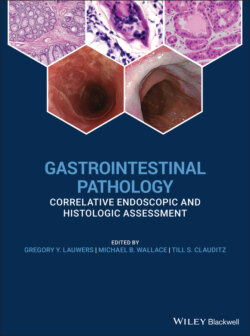Читать книгу Gastrointestinal Pathology - Группа авторов - Страница 100
Microscopic and Immunofluorescence Features
ОглавлениеIn addition to hematoxylin and eosin stained sections, immunofluorescence (IF) studies can be of diagnostic value for the diagnosis of lichen planus and vesiculobullous disorders (Table 2.9). If suspected, additional biopsy samples should be submitted fresh or in an appropriate IF transport medium (e.g. Michel's or Zeus)
Table 2.9 Histologic features of bullous diseases involving the esophagus.
| Cleft | Inflammation | Ancillary IF | |
|---|---|---|---|
| Pemphigus vulgaris | Suprabasal with acantholysis | Mixed, with eosinophils | Intracellular IgG and C3 |
| Bullous pemphigoid | Subepithelial | Neutrophils, eosinophils, fibrin, red blood cells | Linear basement membrane IgG and C3 |
| Epidermolysis bullosa | Subepithelial | Minimal or absent | N/A |
In lichen planus of the esophagus, the histologic features more closely resemble those seen in oral, rather than cutaneous disease. The characteristic histologic features include a prominent band‐like lymphocytic infiltrate involving the epithelium and lamina propria, acanthotic or atrophic mucosal changes, and scattered degenerated or apoptotic keratinocytes (Civatte bodies). The latter are an important diagnostic feature of lichen planus and a distinguishing characteristic from lymphocytic esophagitis. Immunofluorescence studies showing globular IgM deposits at the epithelial‐subepithelial junction along with complement staining in apoptotic squamous cells, similar to cutaneous findings, may be useful in establishing the diagnosis.
Histologically, pemphigus vulgaris is characterized by the presence of suprabasal clefting and intraepithelial blisters due to prominent acantholysis. The intact basal epithelial cells may appear similar to a row of tombstones at the base of the cleft. The blister may be accompanied by a mild superficial mixed inflammatory infiltrate, which includes eosinophils. Immunofluorescence shows characteristic intercellular deposition of IgG and C3, although the results can be negative in early stages or in disease remission.
Bullous pemphigoid shows subepithelial clefting, often containing a mixture of fibrin, red cells, neutrophils, and eosinophils. Immunofluorescence studies may demonstrate the deposition of complement components (typically C3), and linear deposits of IgG at the level of the basement membrane, although these studies may be of limited value if the mucosa has been extensively eroded.
In epidermolysis bullosa, the lesions are thought to be similar to those found in the skin, with the esophageal mucosa exhibiting a subepithelial cleavage plane, with little or no associated inflammatory infiltrate.
